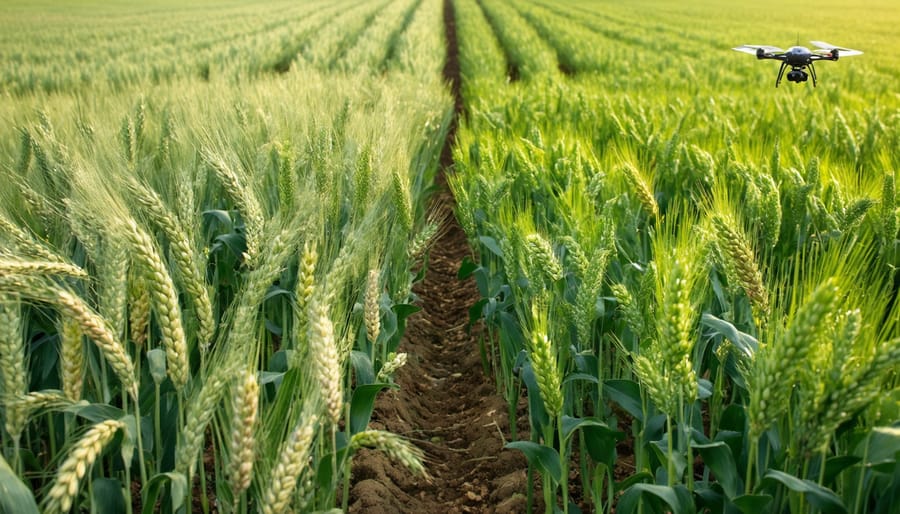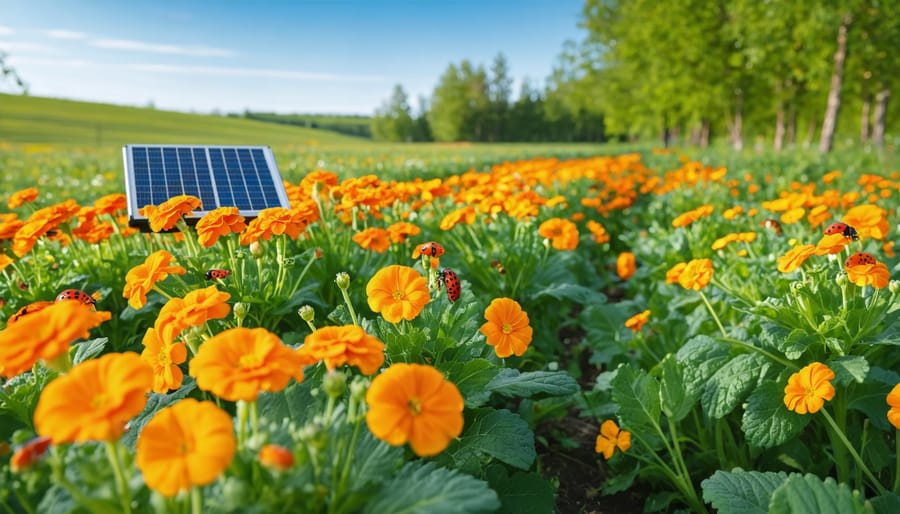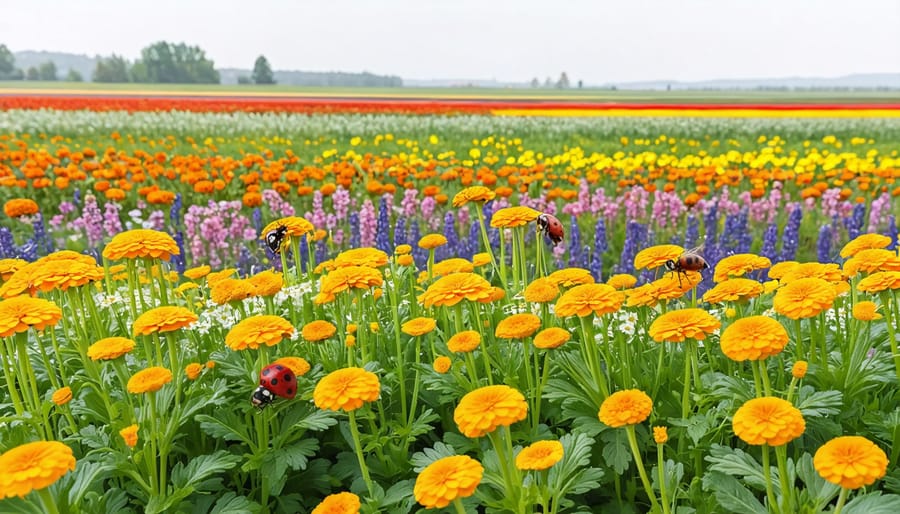Pest-resistant crops stand as a cornerstone of modern Canadian agriculture, offering Alberta farmers a powerful defense against yield losses that cost the industry over $2 billion annually. These innovative varieties, developed through careful breeding and biotechnology, reduce pesticide use by up to 40% while maintaining robust harvests across challenging Prairie conditions. From canola engineered to resist flea beetles to wheat varieties that naturally deter sawflies, these crops represent a critical shift toward sustainable, high-efficiency farming practices that protect both environmental resources and farm profitability.
For Canadian producers facing increasing pest pressures due to climate change, pest-resistant varieties offer a practical solution that aligns with integrated pest management strategies. Recent field trials across Southern Alberta demonstrate that farms utilizing these crops reduced their pest management costs by an average of 35% while maintaining or improving yield quality. This advancement in agricultural technology not only supports individual farm operations but also strengthens Canada’s position as a global leader in sustainable food production.
The growing adoption of pest-resistant crops reflects a broader movement toward resilient farming systems that can withstand environmental challenges while meeting increasing food security demands. These innovations provide farmers with powerful tools to protect their investments and ensure consistent crop performance throughout unpredictable growing seasons.
Understanding Pest-Resistant Crops in Canadian Agriculture
Natural vs. Enhanced Resistance
Crops naturally develop resistance mechanisms through generations of evolution and selective breeding. These inherent defenses might include thicker leaves, bitter compounds, or physical barriers that deter pests. Many Alberta farmers are successfully winning the pest battle naturally by selecting and cultivating these traditionally resistant varieties.
Enhanced resistance, on the other hand, involves modern breeding techniques and biotechnology to strengthen or introduce specific resistant traits. This can include conventional crossbreeding or genetic modifications that help plants produce protective compounds or develop stronger physical barriers against pests.
Both approaches have their place in Canadian agriculture. Natural resistance often provides broad-spectrum protection and aligns well with organic farming practices, while enhanced resistance can offer targeted solutions for specific pest challenges common in our prairie regions. Local success stories show that combining both methods, when appropriate, can create robust pest management strategies that work well in our unique growing conditions.
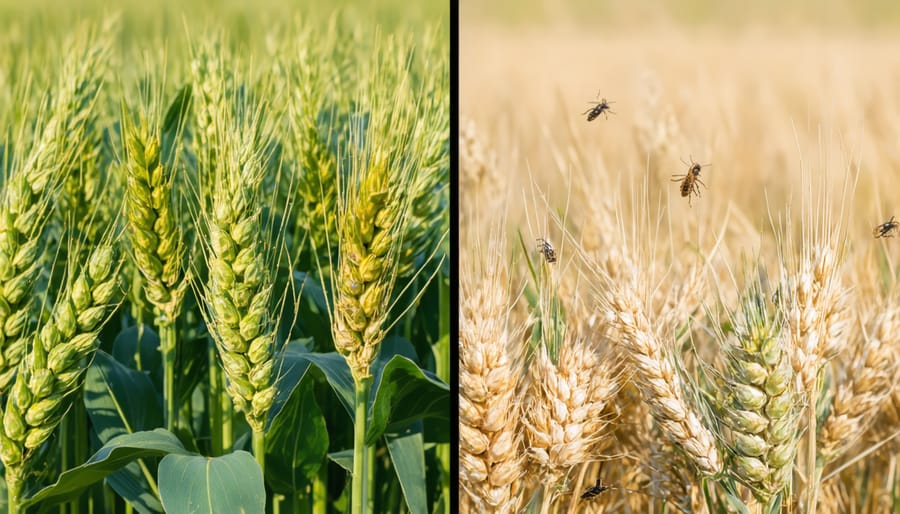
Common Pest-Resistant Varieties in Alberta
Alberta farmers have access to several proven pest-resistant crop varieties that thrive in our unique growing conditions. Hard red spring wheat varieties like AC Muchmore and AAC Brandon show excellent resistance to common wheat diseases and insects, while maintaining high yield potential. These varieties have demonstrated particular strength against wheat stem sawfly, a significant pest in southern Alberta.
In canola production, clubroot-resistant varieties like 45CM39 and CS2600 have become increasingly popular, especially in central Alberta where the disease pressure is highest. These varieties offer protection against multiple clubroot pathotypes while delivering competitive yields.
For pulse crops, CDC Maxim lentils and CDC Frontier chickpeas feature built-in resistance to ascochyta blight, making them reliable choices for Alberta growers. In field peas, AAC Peace Yellow and CDC Meadow varieties show good resistance to powdery mildew and root rot diseases.
Local success stories include Peace Region farmers who’ve reported significant reductions in pesticide use after switching to these resistant varieties, while maintaining or improving their crop yields. These varieties are continually tested at Alberta research stations to ensure their effectiveness under local conditions.
Benefits for Sustainable Agriculture
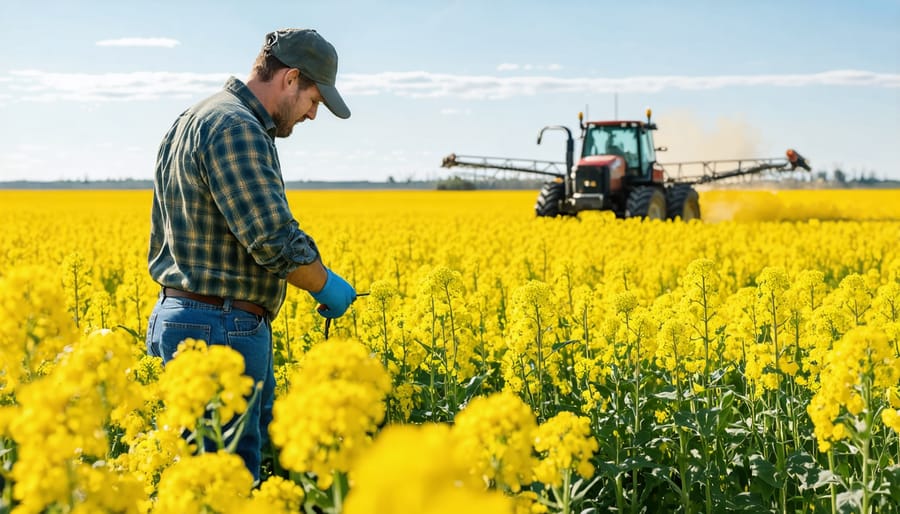
Reduced Pesticide Usage
The adoption of pest-resistant crops has led to a significant reduction in pesticide usage across Alberta’s farming communities, offering both environmental and economic advantages. Recent studies from the University of Alberta show that farmers using pest-resistant canola varieties have reduced their pesticide applications by up to 35% compared to conventional varieties, resulting in average savings of $45-60 per hectare annually.
These reductions complement other proven natural pest control methods and contribute to healthier soil ecosystems. Local farmer Sarah Thompson from Red Deer County reports that since switching to pest-resistant wheat varieties three years ago, she’s observed increased beneficial insect activity in her fields while maintaining consistent yields.
The decreased pesticide use also translates to fewer tractor passes across fields, reducing fuel consumption and soil compaction. Agriculture Canada estimates that pest-resistant crop adoption in Alberta has led to a 25% reduction in fuel costs related to pesticide application. This reduction in chemical inputs not only protects local water sources but also helps farmers meet growing consumer demand for more sustainably produced crops.
For mixed farming operations, the benefits extend to livestock management, as reduced pesticide residues in feed crops contribute to better animal health outcomes and simplified organic certification processes.
Improved Yield Stability
When farmers adopt pest-resistant crops, one of the most significant advantages is the consistency in yield performance across growing seasons. Alberta farmers have reported up to 25% more stable yields when using pest-resistant varieties compared to conventional crops, particularly during challenging pest pressure years.
The economic benefits of this stability are substantial. By reducing yield fluctuations, farmers can better predict their income and make more informed business decisions. Local data from the Alberta Agriculture and Forestry shows that farms using pest-resistant canola varieties experienced 30% less variation in their annual revenues over the past five years.
“The predictability these crops offer has transformed how we approach our season planning,” says Sarah Thompson, a third-generation farmer from Lethbridge. “We can now confidently secure forward contracts and manage our cash flow more effectively.”
This improved stability extends beyond individual farms to benefit the entire agricultural community. More consistent production helps maintain steady supply chains and stable market prices, which is particularly important for Canada’s export-oriented agricultural sector. Additionally, the reduced need for rescue pest control treatments means fewer unexpected expenses during the growing season.
For new farmers or those considering transitioning to pest-resistant varieties, the initial investment often pays off through reduced risk and more predictable returns. Local agricultural extension services offer support programs to help farmers evaluate the potential stability benefits for their specific operations.
Implementation Success Stories
Local Farm Testimonials
John Anderson, a third-generation farmer from Lethbridge, has seen remarkable success with pest-resistant canola varieties on his 2,000-hectare farm. “Since switching to pest-resistant crops three years ago, we’ve reduced our pesticide use by 40% while maintaining consistent yields,” he shares. “The savings on chemical inputs alone have made a significant difference to our bottom line.”
In the Peace River region, Sarah Martinez reports similar positive outcomes. “We introduced pest-resistant wheat varieties last season, and the difference was noticeable. Even during a challenging year with higher-than-usual flea beetle pressure, our crops remained resilient. The investment in these seeds has definitely paid off.”
Red Deer farmer Mike Thompson emphasizes the long-term benefits: “It’s not just about immediate pest control. We’ve observed healthier soil biology and increased beneficial insect populations since transitioning to pest-resistant varieties. Our farm’s ecosystem seems more balanced now.”
The Cooperative Farming Initiative in Medicine Hat, representing 15 local farms, documented a 30% reduction in crop damage from common pests after implementing pest-resistant varieties. “The collective results have been encouraging,” notes coordinator Emily Chen. “Our members are particularly impressed with how these crops perform during extreme weather conditions, which we’ve seen more frequently in recent years.”
These experiences highlight the practical advantages of pest-resistant crops in Alberta’s diverse growing conditions. While initial seed costs may be higher, farmers consistently report that the benefits outweigh the investment through reduced input costs and more stable yields.
Measurable Results
The implementation of pest-resistant crops across Alberta has demonstrated remarkable success, with data from the Alberta Crop Industry Development Fund showing a 35% reduction in pesticide use among participating farms over the past five years. In particular, Bt corn varieties have shown impressive results, with farmers reporting yield increases of 15-20% compared to conventional varieties.
A recent study conducted by the University of Alberta tracked 150 farms that transitioned to pest-resistant canola varieties, documenting an average cost savings of $75 per hectare in pest management expenses. These savings primarily came from reduced pesticide applications and lower labor costs. When combined with smart pest management technologies, these varieties have helped farmers achieve up to 40% better pest control efficiency.
The Lethbridge Research Centre’s long-term field trials have shown that wheat varieties with genetic resistance to wheat stem sawfly have maintained yields 25% higher than susceptible varieties during peak pest pressure years. Additionally, these resistant varieties have demonstrated remarkable durability, with effectiveness lasting an average of 8-10 growing seasons before requiring rotation.
Economic analysis from Agriculture and Agri-Food Canada indicates that farms utilizing pest-resistant varieties have experienced a return on investment ranging from 2.5:1 to 4:1, depending on the crop type and local pest pressure. Perhaps most encouragingly, 89% of surveyed farmers reported increased peace of mind and reduced stress levels after adopting these varieties, citing fewer concerns about pest-related crop losses.
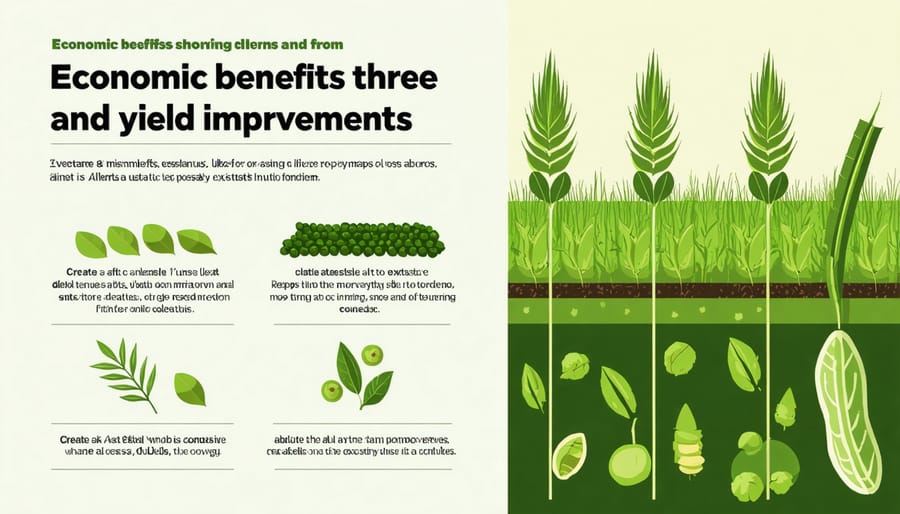
Getting Started with Pest-Resistant Crops
Selection Guidelines
When selecting pest-resistant crop varieties for your Alberta farm, consider your local climate zone, soil conditions, and prevalent pest challenges. Start by consulting with your regional agricultural extension office or joining local farmer networks that have documented community-wide pest management success.
Evaluate your farm’s historical pest patterns and choose varieties that specifically target your most problematic insects or diseases. For wheat farmers in southern Alberta, varieties like AC Stettler and AAC Brandon offer excellent resistance to common wheat stem sawfly. Canola growers should look for blackleg-resistant cultivars rated R or MR (Moderately Resistant).
Consider these key factors during selection:
– Disease resistance ratings from Prairie Recommended Lists
– Maturity dates suitable for your growing season
– Yield potential under local conditions
– Market demand for the variety
– Seed availability and cost
Test new varieties on a small scale before implementing them across your entire operation. Document performance through detailed field notes and photographs. Partner with neighbouring farms to share experiences and create a more robust pest management strategy across your area.
Remember that resistance traits can vary by region, so prioritize varieties that have demonstrated success in Alberta’s unique growing conditions. Your local seed supplier can provide current availability and performance data specific to your area.
Integration Strategies
Successfully integrating pest-resistant crops into your existing operation requires careful planning and a strategic approach. Start by conducting small-scale trials on a portion of your land, typically 2-4 hectares, to evaluate performance and compatibility with your current farming practices. This allows you to assess the variety’s effectiveness while minimizing risk.
Work closely with local seed suppliers and agricultural extension offices to select varieties that are well-suited to Alberta’s growing conditions. Many successful farmers in the region begin their transition during spring planting, incorporating new varieties alongside established crops to maintain steady production.
Consider implementing buffer zones between pest-resistant and conventional crops to prevent potential cross-pollination and maintain crop integrity. A minimum buffer zone of 10 metres is typically recommended for most crop types.
Document your integration process, including planting dates, weather conditions, and pest pressure observations. This information proves invaluable for future seasons and helps fine-tune your approach. Many Alberta farmers have found success by joining local farming networks to share experiences and learn from others who have already integrated pest-resistant varieties.
Remember to maintain your regular pest monitoring program even with resistant varieties. This helps identify any adaptation in pest populations and ensures the continued effectiveness of your pest management strategy. Schedule regular consultations with crop specialists to evaluate the performance of new varieties and adjust your integration plan as needed.
The adoption of pest-resistant crops represents a significant step forward for Canadian agriculture, offering a sustainable solution to the challenges faced by farmers across Alberta and beyond. These innovative crop varieties have demonstrated their worth through reduced pesticide use, improved yield stability, and enhanced farm profitability. By incorporating these crops into existing rotation systems, farmers have reported savings of up to 30% on pest management costs while maintaining robust harvests even during challenging seasons.
The success stories from local farming communities highlight the practical benefits of transitioning to pest-resistant varieties. From canola fields in central Alberta to wheat operations in the prairie regions, these crops have proven their resilience and reliability. The environmental advantages, including decreased chemical inputs and improved soil health, align perfectly with Canada’s commitment to sustainable agriculture.
As we look to the future of farming in Alberta, pest-resistant crops offer a promising path forward. The initial investment in these varieties is offset by long-term savings and increased crop security. Local agricultural extension services and farmer cooperatives stand ready to support those interested in making the transition, providing resources, expertise, and community knowledge.
For those considering the switch to pest-resistant varieties, now is the time to take action. Connect with local agricultural experts, attend community workshops, and learn from neighbouring farms that have successfully implemented these crops. Together, we can build a more resilient and sustainable agricultural future for Alberta.

